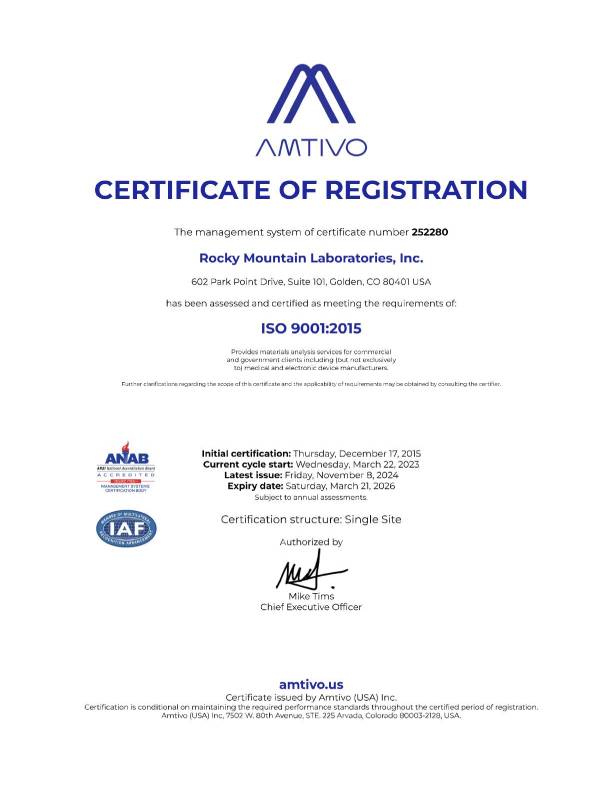Auger Electron Spectroscopy (AES) is a surface-sensitive analytical technique that is commonly used for microelectronics applications. It provides valuable information about the elemental composition and chemical states of materials at the nanoscale. Here’s how AES analysis is beneficial for microelectronics:
Continue reading “AES Analysis for Microelectronics”Blog
AES Analysis for Microelectronics
XPS Analysis for Surface Coatings
X-ray Photoelectron Spectroscopy (XPS), also known as Electron Spectroscopy for Chemical Analysis (ESCA), is a powerful surface analysis technique used extensively in the characterization of surface coatings. Here’s how XPS analysis is beneficial for studying surface coatings:
Continue reading “XPS Analysis for Surface Coatings”AES Analysis for Electronics
Auger Electron Spectroscopy (AES) is an analytical technique used for surface analysis in the field of electronics. It provides information about the elemental composition of a material by detecting the Auger electrons emitted when an atom undergoes a transition after being ionized. Here’s how AES analysis is beneficial for electronic applications:
Continue reading “AES Analysis for Electronics”XPS Analysis for Biomedical
X-ray Photoelectron Spectroscopy (XPS), also known as Electron Spectroscopy for Chemical Analysis (ESCA), is a powerful analytical technique used for studying the surface chemistry of materials. In the biomedical field, XPS analysis is employed for investigating the composition and chemical state of biomaterials, surfaces, and interfaces. Here’s how XPS analysis is beneficial for biomedical applications:
Continue reading “XPS Analysis for Biomedical”SEM Analysis for Integrated Circuits
Scanning Electron Microscopy (SEM) is a powerful imaging technique that can be applied to analyze integrated circuits (ICs) at a microscopic level. Here’s how SEM analysis is beneficial for studying integrated circuits:
Continue reading “SEM Analysis for Integrated Circuits”FTIR Analysis for Biomolecules
Fourier Transform Infrared (FTIR) analysis is a powerful technique used for studying the vibrational modes of molecules. It is widely employed in the analysis of biomolecules, providing valuable information about their structure, composition, and functional groups. Here’s how FTIR analysis is applied to biomolecules:
Continue reading “FTIR Analysis for Biomolecules”Difference between FTIR and Dispersive IR
FTIR (Fourier Transform Infrared) spectroscopy and dispersive IR (dispersive infrared) spectroscopy are two different approaches to obtaining infrared spectra. Here are the key differences between FTIR and dispersive IR spectroscopy:
Continue reading “Difference between FTIR and Dispersive IR”AES Analysis for Composite Materials
Auger Electron Spectroscopy (AES) is a powerful surface analysis technique that plays a crucial role in characterizing composite materials. Composite materials, which consist of two or more distinct components, present challenges in understanding surface composition, interactions, and the distribution of elements. AES provides valuable insights into the elemental composition and surface characteristics of composite materials, offering critical information for optimizing performance and ensuring the quality of composite structures.
Continue reading “AES Analysis for Composite Materials”Difference between the Source Frequency and that seen by the detector in FTIR
In Fourier Transform Infrared (FTIR) spectroscopy, the source frequency and the frequency observed by the detector are related through the process of interferometry. Let’s break down the key concepts:
Continue reading “Difference between the Source Frequency and that seen by the detector in FTIR”Difference between Regular Infrared Spectroscopy And FTIR
Infrared spectroscopy is a technique used to analyze the interaction of matter with infrared radiation. There are two main types of infrared spectroscopy: regular (dispersive) infrared spectroscopy and FTIR (Fourier Transform Infrared) spectroscopy. Here are the key differences between the two:
Continue reading “Difference between Regular Infrared Spectroscopy And FTIR”


